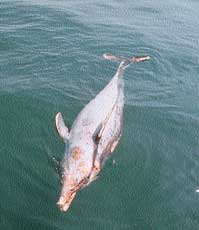Ominous indicators
Ominous indicators

Young chinook salmon chronically exposed to pesticides in the polluted Duwamish waterway in the US state of Washington have a drastically reduced humoral response (an immunological mechanism). Organophosphate pesticides like trichlorfon and dichlorvos frequently used to ward off ectoparasites and plankton in fish ponds in eastern Europe, have been found to reduce non-specific immune response in carp. Reduced humoral response has also been observed in fish in India's Visakhapatnam harbour.
Birds that eat contaminated fish accumulate large quantities of pesticides and polychlorinated biphenyls (pcbs), compounds that are used in the electrical industry. Studies have found that compared with non-exposed birds, herring gull and Caspian tern chicks in the Great Lakes region of usa and Canada had less T-cell activity, another indicator of reduced immunity.
Autopsies carried out on dead whales from the highly contaminated waters of the St Lawrence Seaway in Canada found high concentrations of organochlorine pesticides and pcbs in their body tissues; the whales were suffering from severe bacterial infections, suggesting immunosuppression, and from more frequent and severe cancerous tumours than whale populations anywhere else. In studies published in 1994 and 1995, scientists concluded that exposure to carcinogenic compounds and decreased immunity to development of tumours were two factors which could have contributed to such a high prevalence of cancers in that population.
The strange deaths of dolphins in the Mediterranean, the North Sea and the north Atlantic has attracted greater scientific attention to pesticides and other toxins. People began to find dead dolphins on beaches in the Mediterranean in the early '90s. The dolphins had died from virus-induced infections, normally tolerated by these marine mammals. A British veterinarian reported in 1992: "We have gone back over the literature for more than a hundred years and we found nothing like it, no other cluster of virulent epidemics like we have now.' Scientists have since concluded that exposure to pcbs, organochlorine pesticides and other pollutants made these dolphins more susceptible to viruses. Another study on live bottlenose dolphins captured off the Florida coast found that they had "infections suggestive of immune dysfunction'. The animals had high levels of organochlorine compounds; higher the level of bioaccumulated organochlorines, more decreased was the T-cell lymphocyte proliferative response, a parameter for measuring the immune system.
Over the last decade, there have been unusual mass deaths







